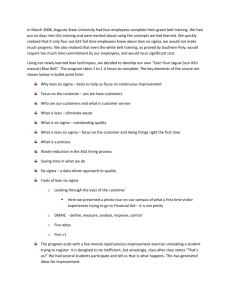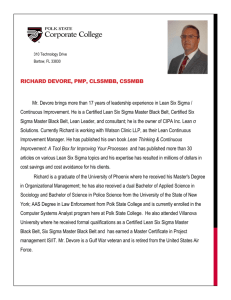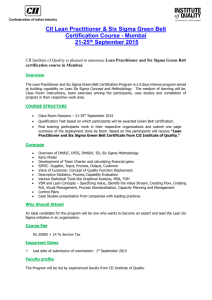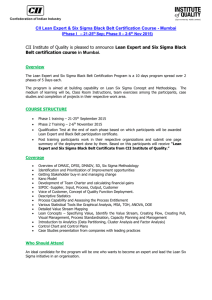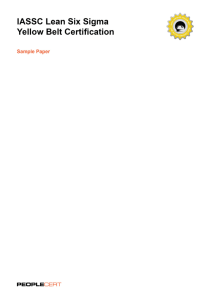Syllabus - Lean Sigma Black Belt Cert
advertisement
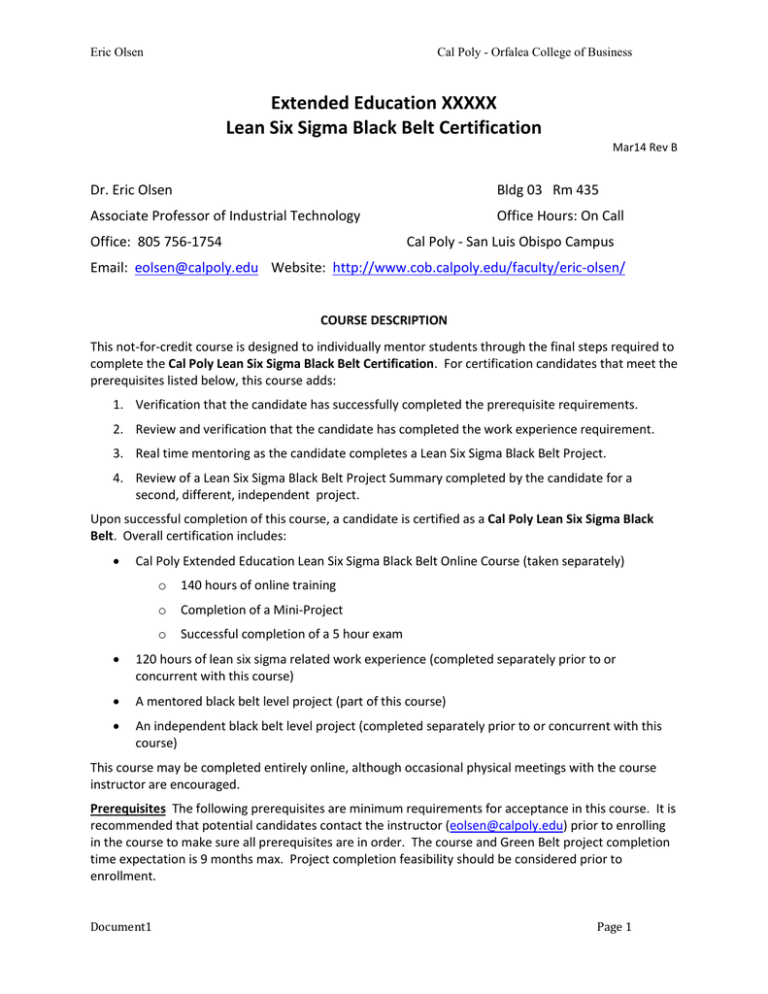
Eric Olsen Cal Poly - Orfalea College of Business Extended Education XXXXX Lean Six Sigma Black Belt Certification Mar14 Rev B Dr. Eric Olsen Bldg 03 Rm 435 Associate Professor of Industrial Technology Office Hours: On Call Office: 805 756-1754 Cal Poly - San Luis Obispo Campus Email: eolsen@calpoly.edu Website: http://www.cob.calpoly.edu/faculty/eric-olsen/ COURSE DESCRIPTION This not-for-credit course is designed to individually mentor students through the final steps required to complete the Cal Poly Lean Six Sigma Black Belt Certification. For certification candidates that meet the prerequisites listed below, this course adds: 1. Verification that the candidate has successfully completed the prerequisite requirements. 2. Review and verification that the candidate has completed the work experience requirement. 3. Real time mentoring as the candidate completes a Lean Six Sigma Black Belt Project. 4. Review of a Lean Six Sigma Black Belt Project Summary completed by the candidate for a second, different, independent project. Upon successful completion of this course, a candidate is certified as a Cal Poly Lean Six Sigma Black Belt. Overall certification includes: Cal Poly Extended Education Lean Six Sigma Black Belt Online Course (taken separately) o 140 hours of online training o Completion of a Mini-Project o Successful completion of a 5 hour exam 120 hours of lean six sigma related work experience (completed separately prior to or concurrent with this course) A mentored black belt level project (part of this course) An independent black belt level project (completed separately prior to or concurrent with this course) This course may be completed entirely online, although occasional physical meetings with the course instructor are encouraged. Prerequisites The following prerequisites are minimum requirements for acceptance in this course. It is recommended that potential candidates contact the instructor (eolsen@calpoly.edu) prior to enrolling in the course to make sure all prerequisites are in order. The course and Green Belt project completion time expectation is 9 months max. Project completion feasibility should be considered prior to enrollment. Document1 Page 1 Eric Olsen Cal Poly - Orfalea College of Business 1. Successful completion of the Cal Poly Extended Education Lean Six Sigma Black Belt Online Course with the following minimum grades: Online Quizzes: 80% weighted average Mini-Project: 80% Online Final Exam: 80% Course grade overall: B- 2. Draft Project Charters (2) for both the required Mentored and Independent Lean Six Sigma Projects. A Project Charter form is included as part of this syllabus. These should be reviewed with the Instructor (eolsen@calpoly.edu) prior to registering for this course. It is the candidate’s responsibility to find acceptable projects for this course. The student may submit a formal appeal to waive select perquisites with the approval of the instructor and adequate demonstration that deficiencies are adequately addressed. Work Experience Requirement Having real world work experience in a lean six sigma related area such as quality control, process improvement, teamwork, and/or project management is an important element in certification. Experience can be paid or unpaid as in an internship, but it must be a formally recognized position within an organization. The minimum requirement is: 120 hours of lean six sigma work experience supported with a detailed description of duties and activities involved signed by your supervisor. Note that the 120 hours is expected to be a sub set of a longer internship experience. Mentored Lean Six Sigma Black Belt Project For certification, each candidate must complete two significant black belt level projects. One project is “mentored” and must be completed under guidance of the course instructor. The minimum required elements of the project are listed under “Project 1” in Appendix A. Note that theses are the minimum requirements and that additional tools and analyses may need to be applied to properly address the Project Charter. Project tracking software from MoreSteam ( https://www.moresteam.com/traction/index.cfm ) is provided to the candidate as part of the course. Independent Lean Six Sigma Black Belt Project For certification, each candidate must complete an independent black belt level project. The three required elements of the project are listed under “Project 2” in Appendix A. See the “Tollgate Review Questions” (Appendix B) for the issues to address in any lean six sigma project. COURSE MATERIALS A. MoreSteam.com’s web-accessed Lean Six Sigma training program. Candidates enrolled in this course can have a 6-month extension to their MoreSteam Black Belt course for free. Additional annual extensions are available direct from MoreSteam at the student rate of $100 or the professional rate of $500. B. Student candidates can download a free copy of Minitab from the Cal Poly Website. Document1 Page 2 Eric Olsen Cal Poly - Orfalea College of Business PERFORMANCE EVALUATION Evaluation based on the candidate’s meeting the minimum acceptable performance criteria for the certification elements covered in this course: 1. Completed the prerequisite requirements – 100% 2. Work experience requirement – 120 hours minimum. 3. Mentored Lean Six Sigma Black Belt Project – Complete to goals agreed to in the Project Charter in conjunction with the Instructor and Project Champion. 4. Independent Lean Six Sigma Black Belt Project – Complete to goals agreed to in the Project Charter in conjunction with Project Champion. POLICIES AND PROCEDURES Expectation on Timing This is an independent, anytime, fixed start course selected by the candidate based on a reasonable expectation that the projects can be completed in a specified period of time. Having previously taken the Cal Poly Extended Education Lean Six Sigma Black Belt Online Course, the student would have a relatively clear view of expectations. They would also do some pre-work and speak to the instructor (mentor) about the feasibility of completing the projects on time. Completing a draft project charter (see Appendix C) is a prerequisite and part of of the course admission process. The course duration is set at 9 months. If the project takes longer than 9 months the student would be given an incomplete and be required to register and pay for the course again. This course can be completed while enrolled at Cal Poly or within 5 years of completing the online training course if no longer enrolled. Personal Integrity Policy The penalty for cheating is expulsion from the course. Cheating occurs when your take credit for work that you did not do. Plagiarism occurs when students copy sections of another author’s material without referencing it. I am a strong believer in accessing resources and discussing problems outside the course, but be sure to give credit where credit is due. Document1 Page 3 Eric Olsen Cal Poly - Orfalea College of Business APPENDIX A Cal Poly Certification Project Requirements Green Belt Requirements Project 1 Project Results Define Measure Analyze Summary statement of project results tying metric performance back to Charter statement mission. Project Charter Black Belt Requirements Project 1 Project 2 X X X X X X Thought Process Map X X S-I-P-O-C Process Flow Map X X Pareto Chart X X Gantt Chart X X CTQC Tree Diagram X X CTQCs Identified with Operational Definition X X Measurement System Analysis X X Trend Chart X X Defect Opportunities Identified X X DPMO Baseline and sigma Level X X Histogram X X Statistical Process Control X X Capability Analysis X X Hypothesis Testing Design of Experiments: Full Factorial or Fractional Factorial Design Select from the following tools: X X NA X Select 3 Select 4 NA Cause & Effect Diagram 5-Why, 1-How Analysis FMEA - Failure Mode & Effects Analysis Regression & Correlation Analysis One-Way ANOVA Document1 Page 4 Eric Olsen Cal Poly - Orfalea College of Business Select from the following tools: Select 4 Select 4 NA Control Plan X X Control Chart(s) showing both BEFORE and AFTER data X X Select 3 Select 3 NA X X Brainstorming Error-Proofing Improve System Dynamics Solution Selection Matrix Corrective Action Matrix Piloting Changes Set-up Reduction Select from the following tools: Control Revised Work Instructions (Standard Work) 5-S Total Productive Maintenance Best Practices - Improvement Integration Affidavit Document1 Signed by organization executive Page 5 Eric Olsen Cal Poly - Orfalea College of Business APPENDIX B Tollgate Review Questions1 Good questions to direct projects. DEFINE 1. What are we trying to accomplish (Mission)? 2. What is the project scope? Is the project scope broad enough to be important, but narrow enough to be do-able? 3. Why are we working on this project? What is the business case for this activity? 4. Who is the customer, and what output (Y) is important to the customer? What are the Critical-To-Quality Characteristics? 5. What are the Operational Definitions for all Critical-To-Quality Characteristics (CTQCs)? 6. How does the current process flow? What are the current inputs to the process? 7. If this project is focused on material or information flow (Lean) has the value stream been mapped? Have cycle times, inventory levels, changeover times, and Takt time been calculated? 8. What resources are required to complete the project? Who is going to work on the project? When must the project be completed? 9. Is the Lean Six Sigma team functioning as effectively as possible? MEASURE 1. Can the CTQCs be objectively measured? 2. Has the success target been determined - in customer terms? 3. Have potentially significant process inputs (Xs) been identified for further screening? 4. Has a data collection plan been developed for the process output(s), or CTQC(s), and those process inputs, which may be deemed significant? 5. Is the Measurement System capable of providing valid and reliable values with an acceptable degree of error? 6. What is the baseline performance (capability) of the process? 7. Are the relevant metrics visible and widely accessible? 8. Are there any opportunities for "Quick Hits" (Kaizen Blitzes or Rapid Improvement Events)? 9. If the process is not capable, have containment actions been implemented to prevent customers from experiencing defects? ANALYZE 1. What improvement actions are necessary to achieve targeted performance levels? 1 Adapted form MoreSteam.com Document1 Page 6 Eric Olsen Cal Poly - Orfalea College of Business 2. Has a process been established to track implementation - with defined responsibility and target dates? 3. Are there any obstacles to improvement? Unintended consequences? Indirect effects? 4. How might the system push back? 5. Is continuous process flow being established? 6. Is the process moving from "Push" to "Pull"? 7. Have improvement action alternatives been evaluated for relative attractiveness? IMPROVE 1. What improvement actions are necessary to achieve targeted performance levels? 2. Has a process been established to track implementation - with defined responsibility and target dates? 3. Are there any obstacles to improvement? Unintended consequences? Indirect effects? 4. How might the system push back? 5. Is continuous process flow being established? 6. Is the process moving from "Push" to "Pull"? 7. Have improvement action alternatives been evaluated for relative attractiveness? CONTROL 1. Have mechanisms been put in place to provide ongoing feedback and prevent backsliding? 2. Are significant characteristics (inputs and process variables) being monitored and improved over time using statistical methods? 3. Are appropriate preventive actions in place to ensure that work processes are performed in a consistent fashion? 4. Has the Process Owner accepted responsibility for the process changes and ongoing process management? 5. Are improvements, lessons learned, and best practices being shared in a systematic fashion? 6. Have you recognized the team's efforts and celebrated success? Document1 Page 7 Eric Olsen Cal Poly - Orfalea College of Business APPENDIX C PROJECT CHARTER Project Name: (1) Business/Location: (2) Enter Project Name Enter Business Unit, Location, Division, or other identifier. Team Leader: (3) Champion: (4) Enter your name Individual responsible for directing efforts of the team. Works with team leader to develop strategies, set direction and goals, acquire necessary resources and resolve barriers or conflicts. Monitors progress of team and makes adjustments as appropriate. Project Description/Mission: (5) Describe the project that the team is expected to complete. What is the team expected to accomplish or deliver. Problem Statement: (6) Describe the problem or opportunity prompting this project activity - in customer terms. Outline what the team is expected to develop or remedy Business Case: (7) Why undertake this project vs. some other activity? Deliverables: (8) List the project deliverables - the process or product changes to be implemented. Goals/Metrics: (9) Qualify or quantify the desired outcome of the team's process or recommendations Process & Owner: (10) Describe the process affected by this project and identify the process owner. Project Scope Is: (11) Qualify or describe the geographic, organizational, physical or other boundaries of the teams reach and solution Project Scope Is Not: Key Customers: (12) Who are the various internal or external customers of the team's process or impacted by the team's recommendations Expectations: (13) To the extent known, what outcomes or metrics do the customers expect? Milestones: (14) Project Start: List the steps that the team is expected to complete as part of the project. Completion Dates: (15) Indicate preliminary dates for completion of the project milestones. Project Completion: Expected Business Benefits: (16) Quantify 1-Time Annual Hard Cost Soft Cost Revenue Speed Compliance Intangible Explanation What are the expected business benefits, both tangible and intangble? Identify the categories impacted with a checkmark, then quantify if possible. Distinguish between onetime benefits and ongoing annual annual benefits. Provide a description to explain the projected benefits and their calculation. Team Members: (17) List the participants on the team or the people involved in the process. Expected Resource Needs (Internal/External): (18) List the nature, time period and intensity of any auxiliary resources likely to be needed as the team progresses in its work. Estimate cost of any external resources required, e.g. consultants Risk Assessment: (19) Describe any material risks associated with the project Prepared By: (20) Who created/revised the Charter? Document1 Date (Last Revision): (21) Note the date of creation and any revisons. Revisions should be approved and signed-off by the Project Champion. Page 8

